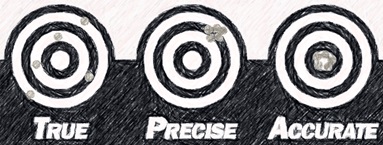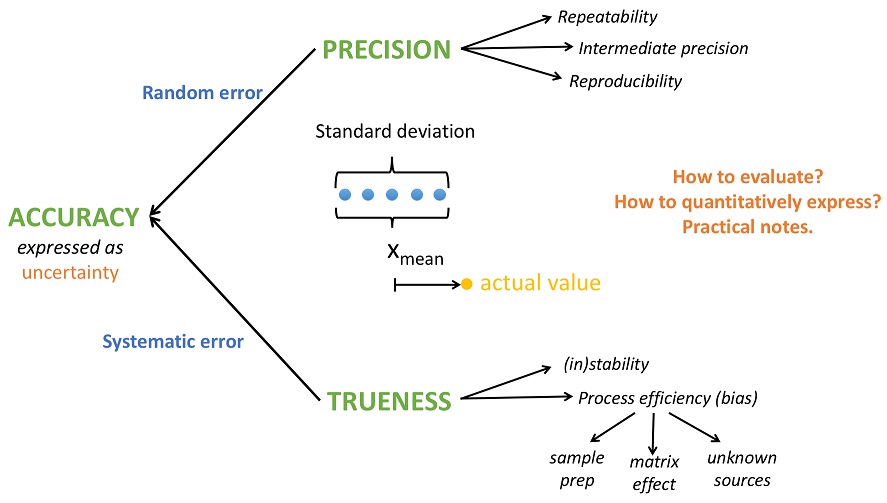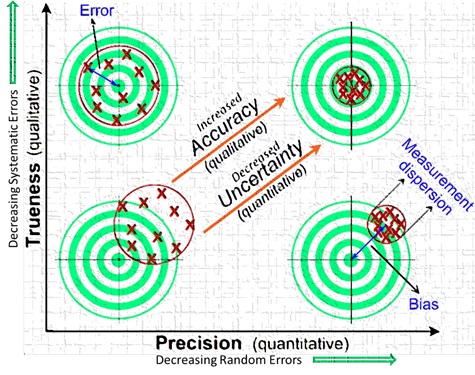
Accuracy and Precision:
The words accuracy and precision are often used almost interchangeably in colloquial usage. However, when it comes to measurement system analysis their meaning, interpretation and usage is widely different. It is important to understand these characteristics since they form a part of a good measurement system.
Accuracy refers to the closeness of a measured value to a standard or known value.
Precision refers to the closeness of two or more measurements to each other.
A good analogy for understanding accuracy and precision is to imagine a basketball player shooting baskets. If the player shoots with accuracy, his aim will always take the ball close to or into the basket. If the player shoots with precision, his aim will always take the ball to the same location which may or may not be close to the basket. A good player will be both accurate and precise by shooting the ball the same way each time and each time making it in the basket.
The words precision, trueness and accuracy are important differentiated terms when referring to measurements in the scientific and technical context. Generally speaking, accuracy refers to how close a measured value is in relation to a known value or standard. However, the International Organization for Standardization (International Standards Organisation – ISO) uses “trueness” for the above definition while keeping the word “accuracy” to refer to the combination of trueness and precision.
On the other hand, precision is related to how close several measurements of the same quantity are to each other. It is rather common to use the terms “bias” and “variability” to refer to the lack of “trueness” and the lack of “precision” respectively.
Precision is sometimes stratified into:
- Repeatability — the variation arising when all efforts are made to keep conditions constant by using the same instrument and operator, and repeating during a short time period; and
- Reproducibility — the variation arising using the same measurement process among different instruments and operators, and over longer time periods.
With regard to Accuracy we can distinguish:
- The difference between the mean of the measurements and the reference value, the bias. Establishing and correcting for bias is necessary for calibration.
- The combined effect of that and precision.

Four Possible States of a Measurement System
It is important to realise that when since accuracy and precision have different meanings in the context of measurement systems, there are 4 possible states that a measurement system can have in this regard. The measurement system under consideration maybe:
- Both accurate and precise
- Accurate but not precise
- Precise but not accurate
- Neither accurate nor precise
When accuracy and precision are present in the system together, it gives measurements that are close to the standard value and to each other. This is the desired state of affairs that every measurement system eventually works toward.

The ISO standard 5725, under the title “Accuracy (trueness and precision) of measurement methods and results”, uses the combination of two terms, “trueness” and “precision”, to describe the accuracy of a measurement method. According to ISO 5725, “Trueness” refers to the closeness of agreement between the arithmetic mean of a large number of test results and the true or accepted reference value. “Precision” refers to the closeness of agreement between different test results.
On the other hand, the Bureau International des Poids et Mesures (BIPM) defines accuracy as the closeness of agreement between a measured quantity value and a true quantity value of a measurand (quantity intended to be measured). In this case, trueness is defined as the closeness of agreement between the average of an infinite number of replicate measured quantity values and a reference quantity value.
Tightly related to accuracy, trueness and precision, is the measurement error, also referred as an observational error. This error that can be quantified by different methods is defined as the difference between the “true” value and the measured value. The systematic part of the observational error is generally related to the trueness of the measurement while its random part is linked to precision.

Accuracy and precision in psychometrics and psychophysics
In psychometrics and psychophysics, the term accuracy is interchangeably used with validity and ‘constant error’, whereas ‘precision’ is a synonym for reliability and ‘variable error’ respectively. Validity of a measurement instrument or psychological test is established through experiment or correlation with behavior. Reliability is established with a variety of statistical technique (classically Cronbach’s alpha).
Content Curated By: Dr Shoury Kuttappa

